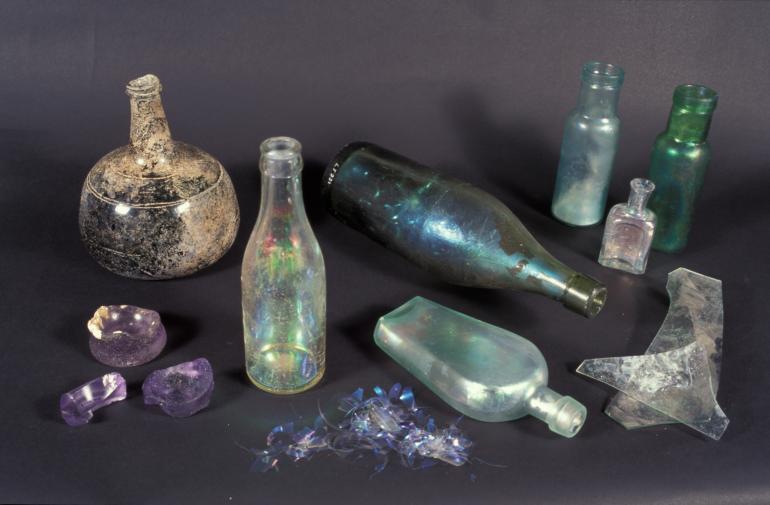Deterioration
Apart from the obvious fragility of glass and its tendency to crack and break, there are other forms of deterioration which occur when glass is in contact with moisture and aqueous solutions (Figure 1).
Figure 1: Examples of glass deterioration in a bottle collection
Surface weathering produces effects which vary greatly, from a loss of transparency to the formation of iridescent layers, crizzling and scaly encrustations.
The reaction of glass with water can be described as “an inward diffusion of water molecules, which then react with non-bridging oxygen atoms to produce hydroxyl ions that migrate out with the alkali cations” (Newton 1989). The surface layer of the glass becomes alkali depleted and protons (hydrogen ions) replace the alkali ions in the glass network. As protons are smaller, this results in shrinkage of the leached surface layer of glass. When the glass dries various forms of deterioration may be observed. The surface may become opaque or iridescent and fine lamellae or thick flakes may fall away.
When flat sheets of glass are stored ‘face to face’ in a humid environment, the trapped moisture will quickly form a leaching solution and attack the glass.
Crizzling, the formation of very fine surface cracking, occurs in glass with a disproportionate composition (excess alkali and insufficient lime). This type of composition is often found in glass of the 16th to the 18th centuries. Crizzled glass objects ‘weep’ when placed in a humid environment, with the droplets of moisture on the surface continuously leaching the excess alkali.
Other environmental influences which adversely affect glass include:
- carbon dioxide and sulphur dioxide which combine with moisture in the air to produce weathering crusts of calcite (CaCO3) and gypsum (CaSO4) as found for example, on old window glass;
- slightly acidic or alkaline soils;
- soluble salts which are inevitably present in glass recovered from a marine environment. If the glass is allowed to dry before being thoroughly washed, crystallising salts will cause surface exfoliation; and
- exposure to sunlight. Decolourised glass, which contains manganese salts, develops a purple hue after prolonged exposure. This effect has even been found in shards recovered from shallow water sites.

